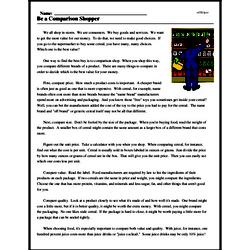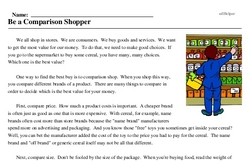Be a Comparison Shopper
We all shop in stores. We are consumers. We buy goods and services. We want to get the most value for our money. To do that, we need to make good choices. If you go to the supermarket to buy some cereal, you have many, many choices. Which one is the best value?
One way to find the best buy is to comparison shop. When you shop this way, you compare different brands of a product. There are many things to compare in order to decide which is the best value for your money.
First, compare price. How much a product costs is important. A cheaper brand is often just as good as one that is more expensive. With cereal, for example, name brands often cost more than store brands because the "name brand" manufacturers spend more on advertising and packaging. And you know those "free" toys you sometimes get inside your cereal? Well, you can bet the manufacturer added the cost of the toy to the price you had to pay for the cereal. The name brand and "off brand" or generic cereal itself may not be all that different.
Next, compare size. Don't be fooled by the size of the package. When you're buying food, read the weight of the product. A smaller box of cereal might contain the same amount as a larger box of a different brand that costs more.
Figure out the unit price. Take a calculator with you when you shop. When comparing cereal, for instance, find out what the cost is per unit. Cereal is usually sold in boxes labeled in ounces or grams. Just divide the price by how many ounces or grams of cereal are in the box. That will give you the unit price. Then you can easily see which one costs less per unit.




